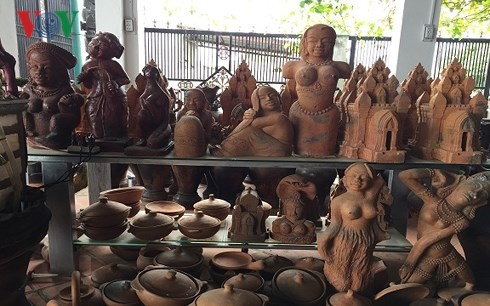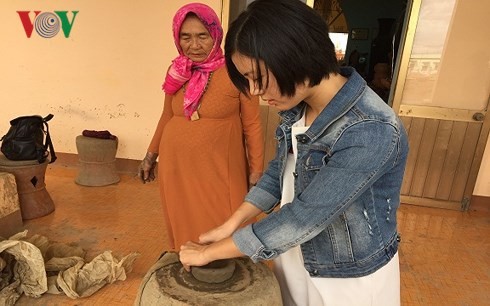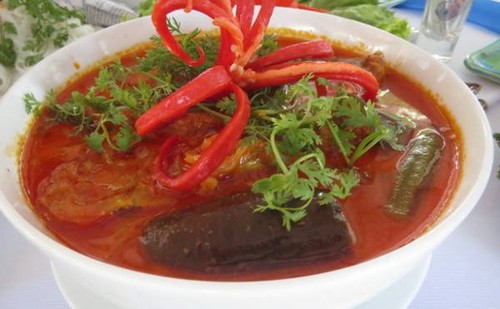The village has an exhibition house for displaying pottery products and related equipment. These include ceramic items for everything use, such as jars, ovens, and pots, as well as flower vases, pitchers, lamps, decorative lights, and statues that reflect the Cham culture.
 Bau Truc ceramic products. Bau Truc ceramic products.
|
Truong Van Tan, owner of the Trang Thao ceramic workshop, says it takes a lot of time and effort to create a single ceramic item. The techniques they use have been passed down from generation to generation. All steps, from soaking the materials in water to mixing in sand and kneading the clay to shaping and adding decorative designs before firing, are done by hand. Villagers take soft sand from the Quao River and mix it with clay to create a basic material with high adhesion. The mixture is put on a table to be shaped. The artisans do not use spinning wheels to shape their products. They move their hands around the clay to create different shapes and patterns. Products are decorated with seashells, snails, or hand-paintings featuring the daily life of the local people. Bau Truc craftsmen use wet cloths to make the product’s surface smooth. After shaping and decorating, the products are dried in the sun, then polished, and then fired. Truong Tan Tan told VOV: "All steps are done manually. No technology is used during the process, making each product unique. Each Bau Truc ceramic item has its own beauty thanks to the potter’s skill."
 |
Kneaded by hand, Bau Truc ceramic products are standalone items demonstrating the talent and unique craftwork of the artisans in the village. "Bau Truc artisans make use of the shaping “style” of Cham folk arts, using simple tools such as bamboo sticks, clam shells and snail shells to engrave patterns, such as symmetrical geometric figures, rivers, and plants into their pottery," said Mr. Tan.
Pottery products from Bau Truc village are not baked in kilns. Artisans cover them with straw and firewood and bake them outdoors at a high temperature for five to six hours. Their unusual coloring and baking techniques give their products unique colors, quite different from those created on a mass production line. Their main colors are a reddish brown embellished with lines of red-yellow, red-pink, and black-grey.
The Cham women in Bau Truc produce the ceramics. Traditionally, girls of 12 or 13 had already mastered clay kneading and shaping. Brides were supposed to make ceramics and cook meals using their own finished products. 67-year-old Dam Thi Ho says the pottery industry in Bau Truc Village is famous for employing strictly manual labor.
"In the past, almost every woman in Bau Truc could make her own pottery items for daily use, such as cooking utensils. With more and more visitors stopping by our village to buy our pottery, we have created new products with more modern designs that cater to our customers’ tastes," said Ms. Ho.
Truong Van Tan says visitors are interested in a wide range of pottery products – statues and reliefs of Cham women, kings, dancing women, and towers, as well as flower vases, plates, and pots.
"In addition to examining the beautiful pottery items on display here, visitors can also watch the artisans create ceramic products from scratch or be shown how to shape their own ceramic products," added Mr. Tan.
Dinh Le Quang Huy works at the Ninh Thuan provincial Center for Tourism Promotion. He told VOV: "Bau Truc village has become a magnet for visitors who wish to learn more about the Cham people’s pottery craft. The village has seen a growing number of both domestic and foreign tourists over the years. In addition to exploring the beautiful scenery of Ninh Thuan, they are very eager to explore the unique culture of the Cham ethnic group."
Bau Truc ceramics have have been listed among Vietnam’s 12 National Intangible Cultural Heritages by the Ministry of Culture, Sports, and Tourism. Bau Truc has applied for UNESCO’s designation as an Intangible Cultural Heritage in need of urgent protection.
Leaving Bau Truc for another Cham village in An Giang province, let’s explore the local Cham people’s recipe for their renowned curry dish.
 Cham ethnic people's cury dish Cham ethnic people's cury dish
|
The local Cham community here are Muslim. They are proud of the architecture of their mosques and houses, their cuisine, especially their curry dishes. Isa Le, a cook in Chau Doc village is making a Cham curry dish. He told VOV: "Cham people abstain from pork so we usually use beef, goat meat, lamb, chicken or duck to make this curry dish. The meat should be stewed at least 2 hours until it become really soft. This dish is served on important occasions like weddings, engagement ceremonies, and traditional festivals."
A Cham curry dish is not complete without coconut milk, which is carefully prepared by the cook. Isa Le is constantly stirring coconut juice in a small pot over the fire. He elaborated: "We have to keep stirring non-stop until the juice gets thicker and turns brown. We then add yellow curry powder to the pot and mix it thoroughly."
Isa Le told us that in order to create the best coconut milk, he has to select a ripe coconut full of juice and cook the juice with the proper amount of salt. Another curry maker, Im Gon, elaborated: "Cham people use a lot of spices in cooking. For the curry dish, we chop all the ingredients - onions, lemongrass, chili, garlic, and cinnamon - into tiny pieces, mix them together, and coat the meat with this mixture before cooking. We stir-fry the ingredients until it smells really good and then put the meat into the pot to stew."
It is said that the curry of the Cham people in An Giang is imported from the Muslim community in Malaysia. In addition to eating curry with bread, like Indian people, Cham people also enjoy curry with rice vermicelli.